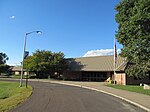Hatfield Center Historic District
1661 establishments in the Massachusetts Bay ColonyHatfield, MassachusettsHistoric districts in Hampshire County, MassachusettsHistoric districts on the National Register of Historic Places in MassachusettsNRHP infobox with nocat ... and 2 more
National Register of Historic Places in Hampshire County, MassachusettsUse mdy dates from August 2023

The Hatfield Center Historic District encompasses the traditional center of Hatfield, Massachusetts. The area, first laid out in 1661, is bounded by Maple Street to the south, the Connecticut River to the east, Day Avenue and School Street to the north, and the Mill River to the west. The area's layout and land use patterns are relatively little altered since they were laid out, leaving a well-preserved early colonial village landscape. The district was added to the National Register of Historic Places in 1994.
Excerpt from the Wikipedia article Hatfield Center Historic District (License: CC BY-SA 3.0, Authors, Images).Hatfield Center Historic District
Valley Street,
Geographical coordinates (GPS) Address Nearby Places Show on map
Geographical coordinates (GPS)
| Latitude | Longitude |
|---|---|
| N 42.361944444444 ° | E -72.600277777778 ° |
Address
Valley Street
Valley Street
01038
Massachusetts, United States
Open on Google Maps







